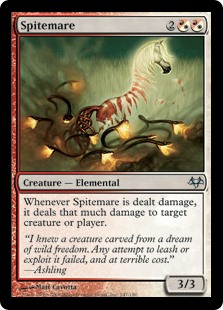Magic is an odd duck in the gaming world, in part because of how the game sells itself to wildly different audiences – largely successfully at that – even though the demands of each group often don’t overlap. Unlike your typical board game, not only are the reasons for why someone plays a game like Magic different, but the parameters for how they play it range quite a bit as well. It may initially have been conceived solely as a two player duel, but Magic: the Gathering barely started making a name for itself before the demand for variations started appearing.
Although the rules were written for two people, players quickly realized that there wasn’t any real rules that prohibited adding more.
Although it’s evident from early set designs that drafting wasn’t part of the original blueprint, within just a couple years the entire process of creating Magic had been revamped to include that as an option.
And although we take for granted now the massively popular arena of tournament play, it took until Ice Age before anything beyond local store tournaments started to codify into a cohesive scene.
Because there was no real road map for a game of its kind, a lot of things sort of evolved organically. Sometimes it was through the publishers themselves; other times through the fans. Some ideas worked. Others failed horribly. There was no real way to know until it was tried. Unlike most games where the rules are the same regardless of who is playing or where you’re playing it, Magic has spent almost 25 years growing along multiple trajectories, and because of all the different groups involved, its whole development has garnered a somewhat symbiotic relationship between the players and the creators.
Maybe not L5R level symbiotic, but still.
Thus, what it means to ‘play Magic’ undoubtedly varies from person to person to a point where the perception of its definition on a gamer level is not unlike the story of the blind men and the elephant: each person involved tends to walk away confident that their way is the way.
This latter belief is especially poignant when a person of one format mindset moves into that of another, bringing with them their preconceived notions of what a ‘good’ card is, how a deck should function, and even the manner in which you should play the game.
A common area you see this played out is choosing what cards to include in your deck. More casual formats, for instance, have much greater levity for cards that require a longer setup or that are included for flavor purposes. More competitive ones favor efficacy, power, and speed above all else.
Since Commander is much more in the former category than the latter, what you seek to use will be different than other formats. Here, speed is less of an advantage than resiliency, and cost is less important than utility. With longer games and more plentiful opponents, the ‘better’ card isn’t always necessarily the right one. As is the case with this week’s pick.
Today we have: Spitemare

Name: Spitemare
Edition: Eventide / Ajani vs Bolas
Rarity: Uncommon
Focus: Damage Dealing
Highlights: Spitemare is the kind of creature that is just frustrating to deal with, whether facing it as an attacker or a blocker. As a 3/3, Spitemare insists that however much damage it takes, it allows you to dish that much out to a creature or player in return. The implications of this are wide-reaching.
At a minimum, it’s often capable of killing whatever creature it meets in combat, making it annoying to block on offense (often guaranteeing it will go unblocked) or an amazing deterrent on defense. The fact that it can also fire direct damage at any creature or player as well gives you a lot of ammunition to pick off problematic creatures or planeswalkers on the board, or provide a serious spike to a player’s life total if the creature it’s facing against is big enough.
Now, the question many experienced players would have is: why Spitemare over Boros Reckoner? Isn’t the latter the more superior card? In isolation, yes, Boros Reckoner is more powerful. It’s one mana cheaper and comes with an extra ability. But that doesn’t automatically make it a better choice for EDH, as illustrated by two simple points.
First, the one mana difference may not actually be a benefit, as the Reckoner requires three Red/White hybrid mana, whereas Spitemare only requires two. It may cost one more mana overall, but having half its cost be generic makes Spitemare much easier to put in decks of more than two colors or those with a lot of utility lands – especially in the earlier stages of the game. Both conditions are fairly common in EDH.
Second, having first strike paired with its damage ability isn’t nearly as useful in EDH as in constructed settings, as you’ll typically be facing down much bigger creatures on average. In this format, the creature is benefiting you either as motivation for others to leave you alone or for you to take full advantage of its powers. First strike as means of setting tempo here doesn’t do much.
So, yes, while the Reckoner may be a clear advantage in other realms, these two cards are largely on equal footing in EDH. And given Spitemare’s aforementioned forgiving mana costs, of the two, it’s actually this one that’ll be the slightly more versatile card overall…even if it wasn’t nearly as famous.
Keep an eye out for us to be regularly featuring other more accessible-but-worth-it Commander cards going forward. In the meantime, we’ll keep the light on for you.
![]()
You can discuss this article over on our social media!
Do you have a particular Commander card to suggest for us to shine a future Spotlight on? You can send suggestions to ryan@cardboardrepublic.com
